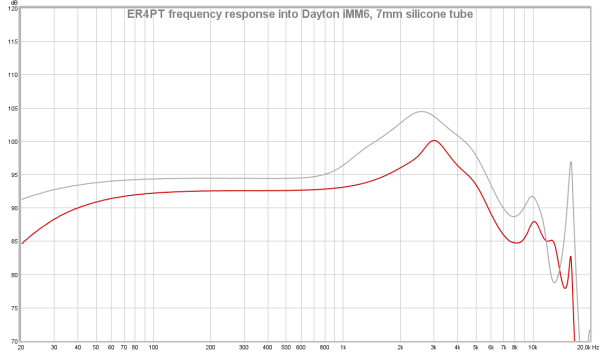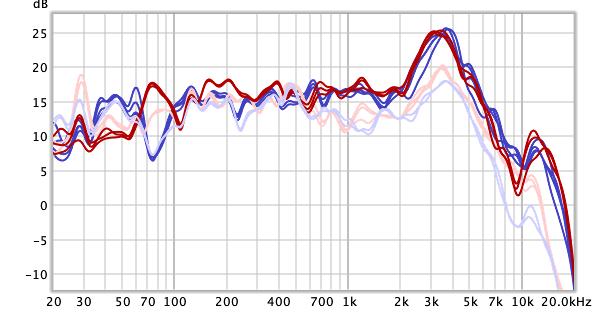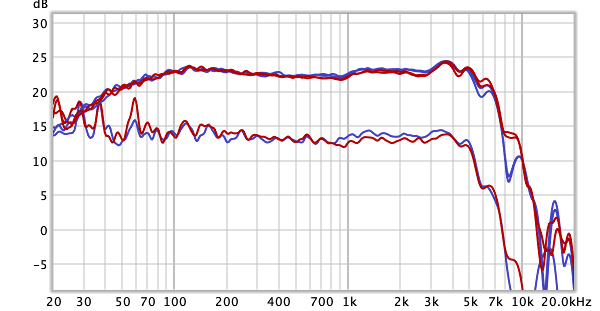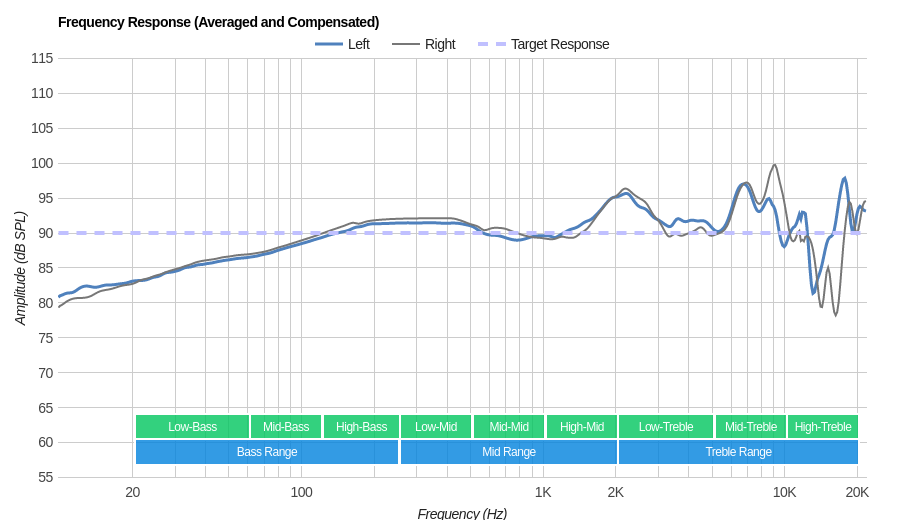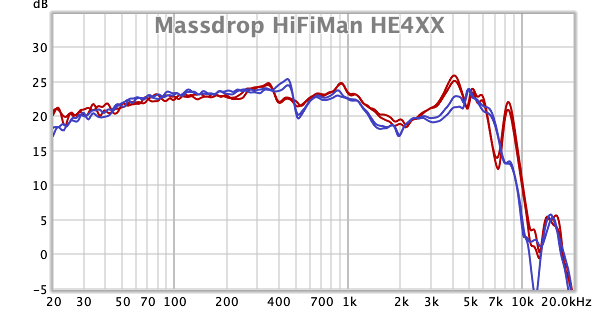Here’s a follow up to
my post last year about the coupler based on the Dayton Audio iMM6 measurement mic. I abandoned the project several months ago because I found a way to get two IEC711 clones from China. And
I’ve already put them to good use while modding cheap IEMs. But I think the results of my experiments with the iMM6-based coupler are interesting in their own right. Maybe somebody else here might find the following an interesting read.
Basically, I wanted to see what could be done to improve the coupler’s response. Sure, you could EQ the output or come up with
a calibration curve. But Isuspect that while this approach can get you a little closer to a more accurate response, it may be the case that you’d need a different calibration curve for different IEMs—or at least for different kinds of IEMs. The acoustic circuit to model the system looks like this:
Source --> IEM’s acoustic output Z --> coupler’s acoustic Z --> iMM6 acoustic input Z
What if the IEM has a very different acoustic output impedance from the one you used to make your initial calibration curve?
An IEC60711 (or IEC60318)-compliant coupler tries to mimic the acoustic transfer impedance of the average human ear. One of the ways it does that is to tune its response using side volumes (really Helmholtz resonators).
It’s not just a simple tube with a mic at the end. Maybe something like this can be done with a DIY iMM6 rig. Unfortunately, the hobbyist may have no reliable and inexpensive way of measuring the acoustic impedance of the coupler. Perhaps the best that can be done with limited means is to emulate the output of the IEC711 coupler for as many kinds of inputs as possible:
Input --> black box --> output
If the black box behaves just like a copy of the real thing with most inputs, then for our purposes, who cares? We’re good to go. Lol. I know, lots of assumptions. But please bear with me.
Here’s another look at the IEC711’s side volumes:
As it says in page 11 of the slides (shown above), the IEC711 coupler has two Helmholtz resonators tuned to match drum impedance. A frequently-given example of a Helmholtz resonator is a bottle. If you blow across the top, you’ll hear a sound at its resonant frequency, which depends on the bottle’s volume and the neck’s geometry. That’s pretty much what’s going on inside the ‘711 coupler. The narrow slits are the bottle necks that lead to the side volumes.
Page 10 above shows the system’s lumped parameter model (LPM) as an LC transmission line (Ma,4, Ma,6, Ma,8, Ca,4, Ca,6, and Ca,8). Each Helmholtz resonator is modeled as an RLC branch (R_, M_, and C_ a,5 for the first one with the opening near the coupler’s reference plane, and R_, M_, and C_a,7 for the second one near the mic).
For each resonator, M and C determine the resonant frequency and R determines the damping, just like in an electrical RLC circuit. In fact, the slides show that this is how they have traditionally modeled the behavior of the coupler. The values of R, M and C are on page 11, and it shows how we can compute the values of R and M from the dimensions of the slit. Later, on page 21, they give the measurements of the first one: the opening is 0.17 mm x 1.11 mm (for a cross sectional area of 0.1887 mm^2) and the length is 2.57 mm.
From the values of M and R given on pages 11 and 14, we can compute the angular velocity at resonance,
ω = 1/√(
MC), from which you can get the frequency. Plugging in the numbers gives 1.19 kHz and 3.5 kHz for each resonator, and these are where the nulls occur in the graph of the undamped response on page 13:
With damping (energy losses from R), the response looks like this:
I circled in green the effect of the first resonator, the one with resonant frequency 1.19 kHz. It has a relatively large contribution to the response, compared to the second resonator, whose effect is subtler. This gives a 4 dB to 5 dB rise to the ‘711 coupler’s response. Our base iMM6-based coupler doesn’t have this behavior. Yet.
Have a look at my first attempt at placing a side volume on the iMM6 coupler:
I drilled a small hole in the side of the tube and stuck in a 19-gauge blunt-tip needle and a 1 mL syringe. Earlier, I mentioned that the ‘711 coupler’s first slit had a cross-sectional area of 0.1887 mm^2. By my calculation, this falls between 24 and 25 gauge. At the time, I didn’t have a 25-gauge needle, so I used 19-gauge, which is much thicker (0.6528 mm^2 cross section). Here’s its effect with an Etymotic ER4PT in the tube:
As the syringe volume gets smaller, the resonant frequency increases and the response swings less. You could compare this to a spring-mass-damper system. The air volume in the syringe is like a spring, as air is compressible and elastic. The mass is the mass of the air inside the needle’s tube. The damping comes from energy loss in viscous flow. Smaller springs and smaller moving masses start off with less energy, so less swing.
Another observation is that the wiggles in the graph look like behavior that's somewhere between the undamped and damped responses in pages 13 and 15 of the AES slides shown earlier. So it looks like we need more damping if we want to copy the damped response on the ‘711 coupler. Also, the red curve above is the response with the syringe already at its minimum volume. To increase the resonant frequency to something close to 1.19 kHz, we can’t decrease the air volume in the syringe any further, but we can still shorten the needle’s tube or increase its width.
I decided to saw off the end of the needle. I didn’t need to make it as short as the ‘711 coupler’s first slit (2.57 mm) because the 19 gauge needle’s larger cross section gives a much higher M (related to mass really) for the same length. Here’s what it looks like:
The needle is a bit shorter now. The picture also shows a bit of earbud foam; part of the piece that’s missing was placed in the air volume to increase the RLC branch’s series R for damping. After playing with it for a while, I discovered that if I instead placed the damper in the needle’s metal tube, then I needed very little foam to get the same result. Also, since the air volume needed to get the resonance close to 1.19 kHz is less than 0.1mL, I found that I could do away with the syringe and just use some putty (Blu-Tack) to seal the air in the needle’s plastic sleeve. Here’s the result:
Before: the iMM6’s base response without the resonator. (Ignore the bass roll-off for now. After taking apart and putting the iMM6 back together, it now has an air leak that I should take care of some day.)
After: the response with the resonator. Frequencies above the bump effectively get around a 3 dB boost. If we subtract the two responses, we see that the biggest difference from my ‘711 clone comes at around 2.3 kHz, where the iMM6 measures approximately 4 dB lower compared to the rest of the spectrum. Also, the peak is a different spot.
I thought about the placing the second resonator near 3.5 kHz, just like on a ‘711 coupler, but maybe being slick about it and getting the resonator’s dip to partially cancel the right side of the 3 kHz peak, thereby shifting the peak lower in frequency.
I also thought about placing a third resonator to fix the response at 2.3 kHz. Maybe if I had used an 8-mm tube instead of 7 mm, I wouldn’t need this fix. I don’t know. I abandoned the project before I could explore it. Here’s where I left off:
Dayton Audio iMM6-based coupler with three Helmholtz resonators, with resonances near 1kHz (19 gauge shortened needle, the one with the black plastic sleeve), 2 kHz (16 gauge, green, damper in tube), and 3.5 kHz (18 gauge shortened needle, orange).
Here were the kinds of measurements I was getting before I put the project aside:
I’m not completely satisfied with the results, but maybe someone out there will have better luck. The seal with the putty isn’t permanent, but it allows for quick changes. After a few months, the parameters probably have drifted. If I had been satisfied with the results, maybe I would have made the seal more permanent.
On the other hand, I’m not completely dissatisfied with the results either. I had some fun playing with it. Here are a few more comparisons:
I stopped working on the project, but I still find it interesting. If you already have a measurement mic, the material cost of constructing and tweaking a coupler is very low, even with these resonators. An added advantage is that you can see the IEM inside the tube and you can mark off where the reference plane should be.
So, if you have a DIY IEM measuring rig, please share what you did to move beyond just having the mic in the tube. Or share any other ideas anyway. For example, I suppose you could buy a ‘711 clone without mic and use whatever measurement mic you have at hand. But I’m glad I ordered the ones with the microphones already included.
Even if this project leads to a dead end, I still found its experiments fascinating. I’m thinking of using some of the ideas here to mod cheap IEMs, maybe even full-size cans, to further tune their response. (Yes, I'm aware that these are old ideas that have been done to death by manufacturers and hobbyists alike.)

































